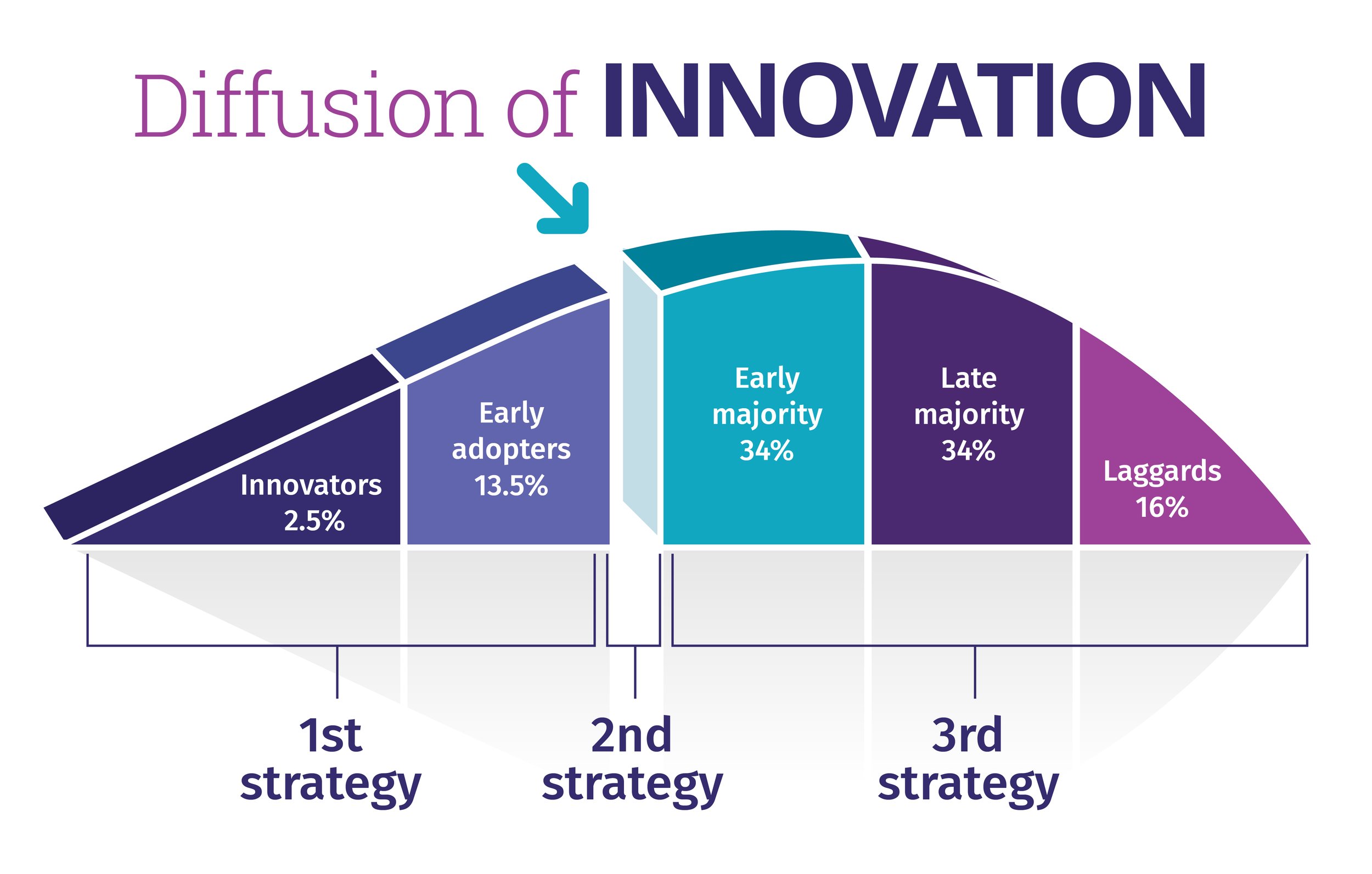Health tech: How to get more paying customers
Why do 95% of health innovations fail? Why do many innovators and business leaders feel stuck on a plateau of too little revenue or no revenue at all?
And most importantly: how do we fix it?!
These are all nuanced questions with complex answers. And, of course, those answers will vary case-by-case.
But there are data-backed models that expose the patterns that make or break health tech adoption — and help to guide innovators on a proven path to getting more paid customers.
I had the pleasure of sitting down with Warren Schirtzinger, Managing Partner at High Tech Strategies. He’s one of the original developers of the “Crossing the Chasm” theory within the Diffusion of Innovation (DoI) model.
You could say he was born with a silver spoon in his mouth: his grandfather was a professor at Ohio State University alongside Everett Rogers, who created the DoI model in 1962!
Wow! That must be why he refers to himself as “the luckiest business person alive.”
Warren learned all about the diffusion of innovations as he grew up. This led to tons of incredible research and accomplishments, including his concept “The Low Risk Recipe™.” (Which I’ll explore another time, so stay tuned!)
Today, I want to share a few game changing ideas Warren and I discussed. These ideas help explain why only 5% of innovations succeed in the market — and how you can be part of that small group that succeeds.
1. Your commercial strategy requires continuous reinvention. The DoI model is your guide.
Part of the DoI model requires that all of your commercial decisions are made to suit your early adopters first — then completely “reinvent” your strategy to penetrate the mainstream majority.
Unfortunately, this isn’t an easy or straightforward task. It requires a lot of observation and analysis. Those who are looking for a shortcut, or who aren’t willing to reinvent their commercialization approach, are setting themselves up for failure.
The key factor that you must always re-examine is the level of risk that each group of potential buyers is willing to take. That’s part of what makes the DoI model so incredibly useful: it shows you how a population or market segment will accept an innovation.
They essentially self-select on the curve. The determining factor is how comfortable they are with risk. Every single time they encounter something new, they’ll evaluate the risk of adoption.
Because this concept is universal, the DoI model is translatable to any industry with any product, service, or idea. And, it has a 90% success rate, so you know it’s worth the effort.
2. It’s not about the tech. It’s about the application.
Many innovators are paying too much attention to the tech or platform, when the actual adoption process is based on the application of that tech or platform. It’s easy to think of the solution itself as the element that’s moving through the adoption process, but it’s really the application that’s moving through.
It’s easy to see why so many players put focus in the wrong place: there’s a massive “hype cycle” that makes tech sexy and the talk of the town. So while it’s great to laud amazing tech when you see it, make sure you’re not losing focus on what matters most.
Another consideration is that each application has its own bell curve. If someone is an early adopter, it’s only for 1 application.
For example, a hospital system can be an early adopter for a blood glucose monitor, but that doesn’t mean they’ll be an early adopter of remote patient monitoring across the board.
Warren shared a funny personal example. His neighbor is an early adopter of electric vehicles, but he still won’t get a COVID vaccination. He’s early on the adoption of one innovation and an absolute laggard in another.
3. Adopting tech always comes at a cost for users.
A new innovation always makes the end user give something up. But often, this risk is too great. If you want to accelerate adoption, your best approach includes keeping intact what people are already using.
For example, consider online grocery shopping. You don’t get to pick your own tomatoes. Sometimes you’re surprised with downright rotten tomatoes… and sometimes you’re surprised with the wrong item all together!
Warren shared an interview he had with a nurse. She said that in the past, she spent 11 hours of a 12-hour shift working directly with patients. But since EHRs came along, she now spends 7 hours working with patients and 4 hours managing EHRs.
When he told her he was working on a new digital health device, her expression looked sad. She said, “Please don’t hurt my patients more than you already have.”
Consider the hit your users are taking when they adopt your tech.
4. What you say about your tech doesn’t actually matter.
When you have a new innovation that’s unknown, and in a market where people aren’t really familiar with the tech, company, or application of the tech, what the vendor says about it doesn’t actually matter.
Yep, you heard me.
It’s estimated that for more than 80% of the buying cycle, the vendor isn’t even involved.
The framework in use is infrastructure education, also called market relations. It’s all about understanding who’s trusted in your market, how you need to educate them with certain kinds of proof, and how they’ll reinforce your message.
It works like an inverted pyramid, where you’re at the bottom and your customer is at the top. In between are all the people who have influence on the buying and adoption process and give credibility to organizations and products. In other words: the people who influence whether you get paying customers or not.
Source: High Tech Strategies
Warren shared a valuable guide. Download it here: “Market Relations Guide: A Framework for Ensuring Long-Term Market Leadership.”
It’s time to follow the evidence
The Diffusion of Innovation model has been around since the 1960s, and it’s 90% effective in driving adoption and growth. You would think these two factors alone would motivate every entrepreneur everywhere to leverage this evidence-based methodology.
But tragically, we’re far from that!
Over the past three and half years, I’ve interviewed hundreds of innovators on my video podcast, The Health Innovators Show. Very few have heard of the DoI model and even fewer use it.
As a health innovator and business leader, the best thing you can do is learn as much as possible about the concept. Accept that you need a different commercial strategy for each market segment. Use the DoI model as your roadmap, use every opportunity you can to apply it to your market strategy.
Or, hire a commercialization expert like Warren or myself to help you build your commercial strategy based on the DoI model, so you can get more paying customers now!








